Sponsored Content by SCIEXReviewed by Louis CastelSep 25 2025
This article presents a comparative study to evaluate the sensitivity performance of the SCIEX 7500+ system for quantifying pesticides in orange juice.
Food and beverage samples are well-known for their complexity and contribute to matrix effects via co-extractables. In addition, these matrices are known to cause instrument contamination.
The SCIEX 7500+ system with Mass Guard technology1 was created to improve instrument robustness while retaining the sensitivity of the SCIEX 7500 system.
A quantitative approach for evaluating more than 200 pesticides in orange juice proved method transferability and equal sensitivity from the SCIEX 7500 to the more robust SCIEX 7500+ systems (Figure 1).
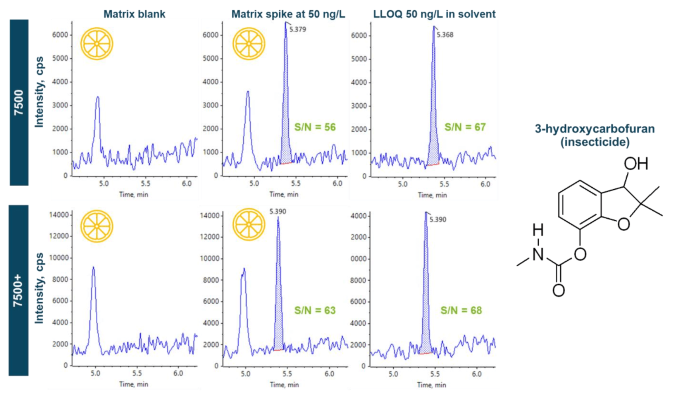
Figure 1. Seamless method transfer to the SCIEX 7500+ system while retaining equivalent sensitivity performance on the SCIEX 7500 system. Representative extracted ion chromatograms (XICs) of 3-hydroxycarbofuran in the blank orange juice (left panels), orange juice post-spiked (middle panels) at the same concentration as the in-vial lower limit of quantitation (LLOQ) of 50 ng/L in solvent (right panels), are shown on the SCIEX 7500 system (top) and the SCIEX 7500+ system (bottom). The sensitivity of both instruments enabled the use of solvent-based calibration and a small injection volume of 1 µL, which, in turn, reduced the matrix effects to <10 % as demonstrated by the similar peak areas between the post-spiked matrix and solvent standard. Image Credit: SCIEX
Key benefits of pesticides quantitation on the SCIEX 7500+ system
- Easy method transfer and comparable quantitative performance: Both the SCIEX 7500 and SCIEX 7500+ systems achieved equivalent lower limits of quantitation (LLOQ) values (mid ppt to high ppb) using the identical instrument and compound parameters.
- Rapid sample preparation and low matrix load: The sensitivity of both systems allowed for quick dilution and 1 µL injection volumes, reducing matrix effects and the requirement for substantial sample cleanup.
- User accessibility to front-end cleaning: Routine maintenance, including self-directed removal and cleaning of the DJet+ assembly, contributes to the robustness of the SCIEX 7500+ system.
Introduction
The analysis of pesticides in food and beverage matrices is critical for food safety. The European Commission has established maximum residual limits (MRLs) for pesticide residues in food and animal feed.
As a result, much effort is dedicated into quantitative investigation of these molecules. High-performance liquid chromatography-mass spectrometry (LC-MS/MS) is a potent analytical technology used for pesticide residue monitoring in food due to its excellent sensitivity and specificity.
Detection of pesticide residues is difficult due to pesticide chemistry and occurrence diversity, as well as the complexity of food matrices. Given that many pesticides have EU MRLs in the sub-to-low parts per billion (ppb) range2, equipment resilience is critical for preserving assay sensitivity and analytical productivity.
The SCIEX 7500+ system incorporates Mass Guard technology1 to enhance robustness while preserving the high sensitivity of the SCIEX 7500 system. These dedicated hardware components reduce instrument contamination and improve access to the front-end DJet+ assembly, making cleaning easier and more efficient.3
The SCIEX 7500 and SCIEX 7500+ systems had comparable sensitivity (S/N within ±20%) and similar LLOQ values (mid-ppt to high-ppb) for the pesticides studied.
In both systems, more than 90% of the pesticides had LLOQs lower than the universal default MRL of 0.01 mg/kg, which is given for most pesticides.3
Methods
The same LC conditions and MS parameters were applied to both the SCIEX 7500+ and SCIEX 7500 systems. The same samples were used for analysis across both platforms.
Samples and reagents: The iDQuant standards kit4, which contains over 200 pesticides, was utilized to create solvent calibration standards and matrix spikes in orange juice. A series of mixed stock standard solutions (1-1000 ng/mL) was produced in acetonitrile and kept at -20 °C until analysis.
An aqueous-based calibration curve (10-50,000 ng/L) was created in MilliQ water for LC-MS/MS analysis. Orange juice was purchased from a nearby supermarket and refrigerated at -20 °C until analysis.
Sample preparation: After thawing, a typical 50 mL aliquot of orange juice was centrifuged at 4000 rpm for 5 minutes to settle the pulp. A 1 mL aliquot of supernatant was diluted with 9 mL of water and filtered through a 0.45 µm syringe filter (VWR International) for matrix post-spikes.
The final spiking quantities in the extract ranged from 50 to 5000 ng/L, which corresponds to 5 to 500 ng/L based on a 10x dilution during sample preparation. The final extracts were put straight into the LC-MS/MS analysis.
Chromatography: Chromatographic separation was done on a Shimadzu Prominence LC20 system with a Phenomenex Kinetex Biphenyl column (2.1 x 50 mm, 2.6 µm, 100 A, P/N 00B-4622-AN). A flow rate of 0.4 mL/min, injection volume of 1 µL, and column temperature of 40 °C were utilized. Table 1 shows the LC gradient used.
Table 1. LC gradient. Source: SCIEX
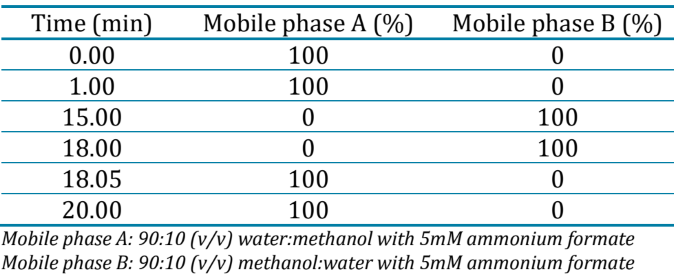
Mass spectrometry: Analysis was carried out utilizing scheduled multiple reaction monitoring (sMRM) with polarity switching on both systems. Table 2 displays the source and gas characteristics used in both systems.
Table 2. Source and gas parameters. Source: SCIEX

The analyte panel had 410 positive and 48 negative transitions that were monitored with a 5 ms pause and 15 ms settling time. Optimized MRM transitions were employed.
Figure 2 shows the sMRM summary plot of retention times (RTs), allowing the user to visually determine if the cycle time or dwell durations required adjustment based on the MRM concurrency.

Figure 2. sMRM summary plot of the RT distribution of analytes. The coloured bars represent the individual RT window of each MRM transition monitored in the method. Image Credit: SCIEX
Data processing: Data collection and processing were carried out using SCIEX OS software versions 3.3.1 and 3.4.0. Peaks were automatically merged using the MQ4 algorithm, and quantification was done with a weighting of 1/x.
Quantitative performance of the SCIEX 7500+ system and 7500 system
On the SCIEX 7500 and SCIEX 7500+ systems, the target pesticides panel was measured using a solvent-based calibration curve that covered at least 3 orders of magnitude and had r2 values greater than 0.99 for the majority of analytes.
To demonstrate the ease of method transfer and to produce a normalized instrument comparison, the identical instrument and compound parameter settings were used on both systems, and all experiments were performed using the same HPLC system.
The converter tool in SCIEX OS software enabled a seamless transfer of method settings, ensuring that the same acquisition methods were employed on both platforms (Figure 3).
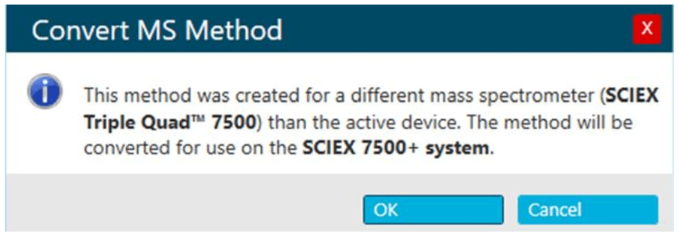
Figure 3. Method conversion in SCIEX OS software. Method conversion between different LC-MS/MS systems is enabled for all instrument models supported by the software. Image Credit: SCIEX
Figure 4 illustrates the sensitivity of both systems by directly comparing the quantitative results for a representative example pesticide, cymoxanil. The statistics windows generated by SCIEX OS software display the mean concentration, standard deviation, precision (%CV), and average accuracy (%) determined from triple injections of the solvent-based calibration curve on the two systems.
The linear performance of each system, as measured by the r2 value and linear dynamic range (LDR), is shown on the right side of the statistics panel. For cymoxanil, both systems obtained an accuracy range of 91-115 % and precision of <15 % CV, with an r2 value of 0.998.
Most analytes had acceptable accuracies within ±30 % and %CV <25 % at the LLOQs, whereas accuracies within ±20 % and %CV <15 % were frequently reached at all other calibration levels.
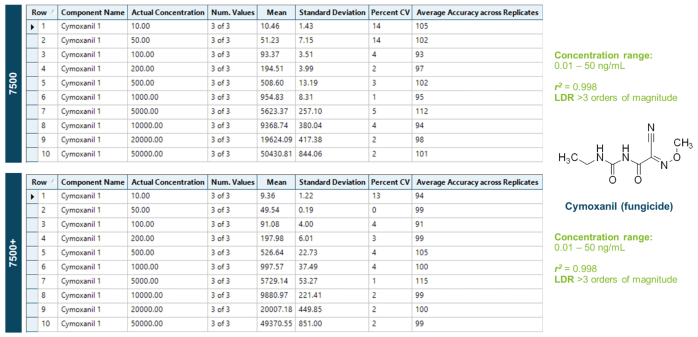
Figure 4. Comparison of the quantitative performance of an example fungicide, cymoxanil between the SCIEX 7500 system (top) and SCIEX 7500+ system (bottom). Mean accuracy and precision (%CV) were calculated from triplicate injections of each concentration across the solvent-based calibration curve, as shown by the statistics panes in the Analytics module of SCIEX OS software. Image Credit: SCIEX
Figures 5A and B show pesticide measurements in the solvent and orange juice matrix. Figure 5A shows sample XICs of an example herbicide, diuron, in the solvent blank, solvent standards at the LLOQ of 10 ng/L and 100 ng/L, and orange juice post-spiked at 100 ng/L acquired in positive ion mode using the two systems.
Except for the solvent blank, which displays no apparent peak for diuron, all peaks exhibited S/N values greater than 10, indicating that they exceeded the instrumental LOQs for this compound. Figure 5B shows another sample set of XICs for the pesticide fipronil, obtained in negative ion mode.
As with the diuron data, the S/N ratio values are >10 for all concentrations examined, and the results were consistent across both instruments. In addition, Figures 5A and B show similar peak regions for the 100 ng/L solvent standard and the orange juice matrix post-spiked at the same concentration.
The matrix effects of diuron and fipronil on both systems were <10 %, as calculated by dividing the peak areas in the post-spiked matrix by the solvent standard.
The sensitivity of the SCIEX 7500 and SCIEX 7500+ systems allowed for rapid sample preparation and 1 µL injections, which helped reduce matrix effects and simplified quantification through solvent-based calibration.
The insets of figure 6 show another measure of instrument equivalency: the distribution of normalized S/N ratios for 205 pesticides (500 ng/L) detected on the two systems. Each pesticide was measured in triplicate on both equipment, and the S/N ratio was computed using SCIEX OS software.
These values were then normalized by dividing the S/N value computed using the SCIEX 7500+ system by the S/N value obtained using the SCIEX 7500 system. A value of 1.0 represents equal S/N values for each instrument.
The majority of pesticides have S/N ratios within 20 % of each other, as shown by the green lines representing the mean ± 20 %.
The insets of Figure 6 displays a histogram of the same distribution, with the green shaded area indicating the ±20 % range. These data reveal that the results obtained with both equipment have identical S/N ratios, supporting the conclusion that both methods have equal sensitivity for measuring pesticides.
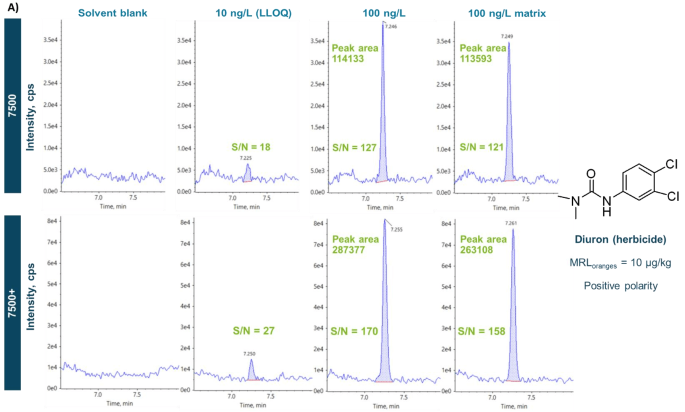
Figure 5a. Representative XICs of an example herbicide, diuron, in the solvent blank, in solvent standards at the LLOQ of 10 ng/L and 100 ng/L and in orange juice post-spiked at 100 ng/L acquired in positive polarity using the SCIEX 7500 system (top) and SCIEX 7500+ system (bottom). Image Credit: SCIEX
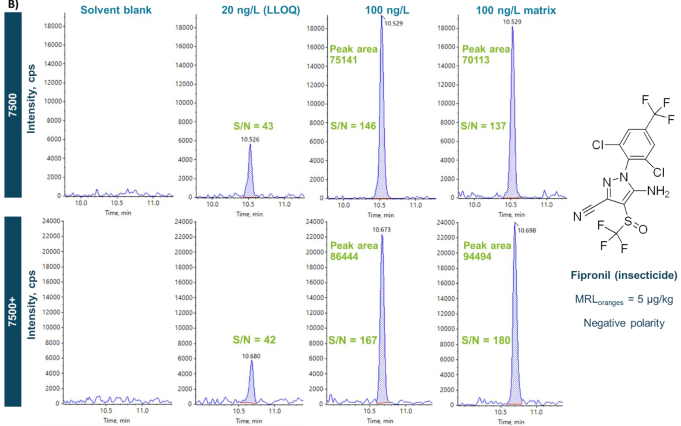
Figure 5b. Representative XICs of an example insecticide, fipronil, in the solvent blank, in solvent standards at the LLOQ of 20 ng/L and 100 ng/L and in orange juice post-spiked at 100 ng/L acquired in negative polarity using the SCIEX 7500 system (top) and SCIEX 7500+ system (bottom). Image Credit: SCIEX
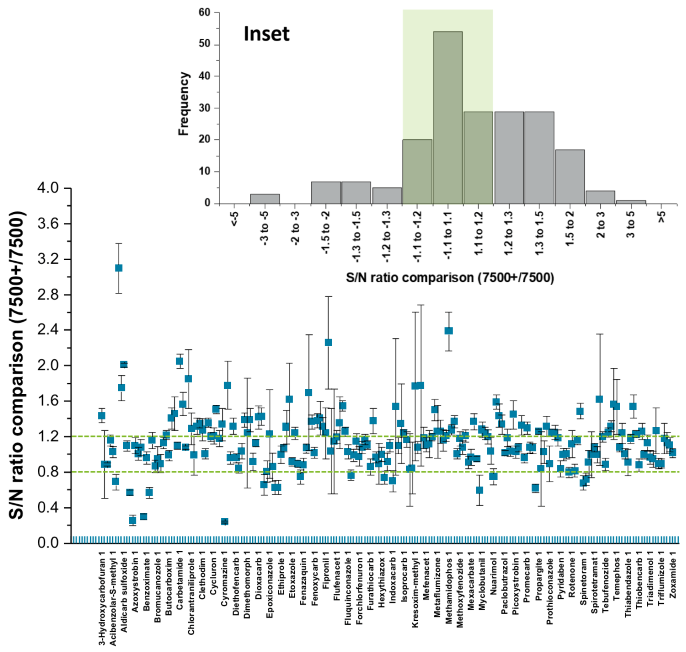
Figure 6. Comparison of signal-to-noise (S/N) ratios for 205 pesticides (a subset of the total panel) between the SCIEX 7500+ system and SCIEX 7500 system. Each data point represents the average S/N and its associated standard error calculated from triplicate injections of a 500 ng/L mixed pesticides standard in solvent. The green dotted lines highlight the compounds with S/N within ±20 % between both systems. Inset: Frequency distribution of S/N comparison between the SCIEX 7500+ system and SCIEX 7500 system. Most of the pesticides demonstrated a S/N ratio difference in the range of -1.2 to 1.5 between the SCIEX 7500+ and SCIEX 7500 systems. Image Credit: SCIEX
Figures 4-6 provide representative examples from the broad pesticide cohort examined.
Figure 7 (below) provides a visual representation of the whole sample set of analytes by overlaying the distribution of LOQ values from data collected on the SCIEX 7500 system (top, blue) and the SCIEX 7500+ system (bottom, green).
The LOQ values span from low ppt to high ppb, and the distributions are nearly identical for both instruments.
More than 90 % of pesticides evaluated on both systems exhibited LOQ values below the average MRL value of 10 µg/kg for most pesticides in the raw orange commodity, as indicated by the vertical red dotted line in Figure 7.
The sensitivity of the SCIEX 7500 and SCIEX 7500+ systems allowed for the quick quantification of more than 200 pesticides in orange juice via direct injection without the need for substantial sample preparation.
The dilute-and-shoot strategy reduced matrix load in both systems, reducing matrix effects and allowing for quantification using solvent-based standards.

Figure 7. Overlaid comparison of the LOQ distribution achieved on the SCIEX 7500 system (top, blue) and the SCIEX 7500+ system (bottom, green). The in-vial LOQs ranged from 0.01 to 5 ng/mL based on the lowest calibration level meeting the acceptance criteria of accuracy (±30 %) and precision (%CV <20 %). Expressed on a per mass basis using the orange juice density of 1.038 g/mL and a 10x dilution of the juice during sample preparation, the LOQs were converted to be in the range of 0.1 to 50 µg/kg (ppb). In both systems, >90 % of the pesticides demonstrated LOQs below the typical MRL of 10 µg/kg (red dotted line) specified for most pesticides. Image Credit: SCIEX
Conclusion
- The SCIEX 7500+ system achieved equivalent or lower LOQ values for 90% of pesticides measured as compared to the SCIEX 7500 system.
- The S/N calculations for pesticides were similar, if slightly higher, on the SCIEX 7500+ system as compared to the SCIEX 7500 system.
- User access to the DJet+ assembly allows for convenient front-end cleaning and system uptime for routine analysis.
References and further reading
- Lee, H. et al. (2022). Achieving exceptional robustness for PFAS analysis in food with the next-generation SCIEX 7500+ system. (online) Available at: https://sciex.com/tech-notes/food-beverage/food-and-beverage/achieving-exceptional-robustness-for-pfas-analysis-in-food-with-the-next-generation-sciex-7500-plus-system.
- European Commission. EU Pesticides Database. (online) Available at: https://food.ec.europa.eu/plants/pesticides/eu-pesticides-database_en.
- Build resilience with the 7500+ system. SCIEX brochure, MKT-31468-A.
- Schreiber, A. et al. Using the IDQuant™ Standards Kit for pesticide analysis to analyze residues in fruits and vegetable samples. (online) Available at: https://sciex.com/content/dam/SCIEX/pdf/tech-notes/all/idquant-pesticides-mass-spectrometry-3370211-01.pdf.
Acknowledgments
This article was produced using materials originally authored by Holly Lee1, Michael Deng1, Craig M. Butt2, Paul R.S. Baker2, and Craig M. Butt2
1 SCIEX, Canada
2 SCIEX, USA
About SCIEX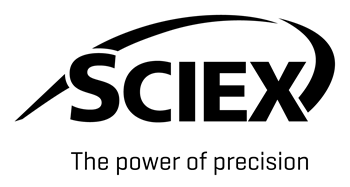
The SCIEX mission is to deliver solutions for the precision detection and quantitation of molecules, empowering our customers to protect and advance the wellness and safety of all.
SCIEX has led the field of mass spectrometry for 50 years. From the moment we launched the first ever commercially successful triple quad in 1981, we have developed groundbreaking technologies and solutions that ensure global food safety today.
Today, as part of the Danaher family of global life science and technology innovators, we continue to pioneer robust solutions in mass spectrometry and capillary electrophoresis. But we don’t just develop products. It is what we do together with our customers that sets them apart. That’s why thousands of food experts around the world choose SCIEX to get the answers they can trust and keep running - day in and day out with consistent performance.
We proudly stand behind our tagline: The Power of Precision.
Sponsored Content Policy: News-Medical.net publishes articles and related content that may be derived from sources where we have existing commercial relationships, provided such content adds value to the core editorial ethos of News-Medical.Net which is to educate and inform site visitors interested in medical research, science, medical devices and treatments.